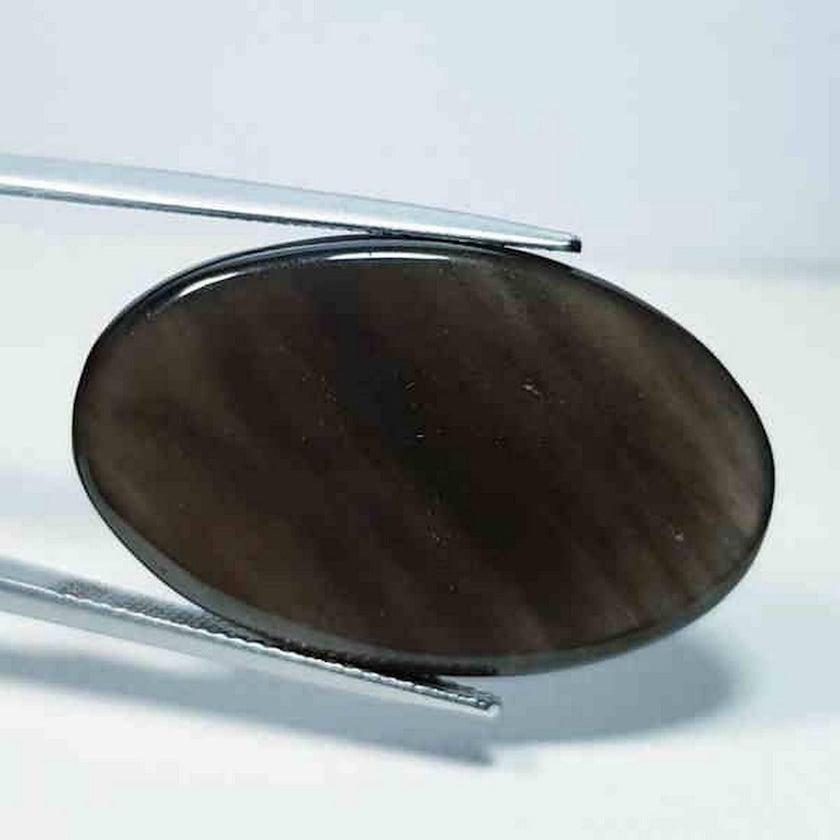Obsidian Value, Price, and Jewelry Information
Obsidian is the most common form of natural glass and occurs in many attractive varieties. Since prehistoric times, people have used this material to make jewelry and carvings as well as practical objects, like knives.
3 Minute Read
Obsidian is the most common form of natural glass and occurs in many attractive varieties. Since prehistoric times, people have used this material to make jewelry and carvings as well as practical objects, like knives.
Start an IGS Membership today
for full access to our price guide (updated monthly).Obsidian Price
Comments
Formed by volcanism, obsidian is considered a rock. It commonly occurs in large pieces, and lapidaries frequently cut them into cabochons, beads, and carvings. Faceted pieces tend to appear dark, except when cut in small sizes. These gems can make delicate jewelry stones.
Heat-sensitive obsidian has a hardness of 5-6 and brittle tenacity. As a result, cutting and wearing this material requires some care. However, the broken edges of these rocks are sharper than any steel knife. Cultures across the globe have made scalpels, arrowheads, knives, and scrapers from obsidians.
Varieties
Transparent obsidians are quite rare, as are green, blue, and reddish colors. Hobbyists will occasionally facet these pieces. Obsidians can also display cat's eyes.
Although typically dark and opaque, obsidians come in many varieties popular with jewelry enthusiasts and mineral collectors.
Snowflake Obsidian
This popular variety gets its name from its inclusions of snowflake-like spherulites of cristobalite. Jewelry makers frequently use these stones as beads and cabochons.
Apache Tears
Beginning hobbyists often enjoy working with these cores of unaltered glass in nodular shells of decomposed obsidian. Commonly found in the southwestern American states of Arizona, Nevada, and New Mexico, some of these pieces have been faceted. This variety name comes from a legend of the Native American Apache people.
Mahogany Obsidian
A variety with reddish-brown color due to iron impurities.
Rainbow and Fire Obsidians
These varieties can show multiple brilliant colors due to inclusions of magnetite nano-crystals. The "fire" variety contains thinner layers of magnetite than the "rainbow" variety.
Sheen Obsidian
A variety with sheen produced by inclusions of gas bubbles.
Pele's Hair
Named after the Hawaiian goddess of volcanos and fire, this light, string-like volcanic basalt glass can actually become airborne. It can catch on trees and outdoor structures.
Identifying Characteristics
Natural obsidians may contain some specific inclusions, such as crystallites, that help distinguish them from artificial glass. Due to the difference in their refractive indices (RI), these will usually stand out in high relief when examined under magnification. Obsidians may also have straight banding and needles, two more telltale signs of natural origins.
Although not a definitive test, checking for magnetic reactions may help confirm a glass piece as natural. Obsidians can have a moderate to very strong reaction.
Some commonly encountered natural gemstones that may be substituted or confused with obsidians are jet, chalcedony, and schorl (black tourmaline). However, standard gemological tests should distinguish them. The specific gravity range of both chalcedony and schorl overlaps with that of obsidian, but an RI test should separate them.
Synthetics
You might encounter artificial or manufactured blue, green, or red glass pieces passed off as natural obsidians with these rare colors. See our glass gem listing for more information.
Sources
The United States is a major source of gem-quality material. Arizona, Colorado, and California each have several productive localities. Utah is a major source of the snowflake variety.
Other notable American sources include the following:
- Hawaii: Pele's hair and other varieties
- New Mexico: Apache tears
- Oregon: fire, mahogany, and rainbow varieties
- Wyoming: notably Yellowstone National Park
Mexico yields an abundance of banded and sheen varieties.
Other notable producers including the following:
- Brazil; Ecuador; Iceland; Indonesia; Italy; Japan.
Stone Sizes
Fragments range from microscopic to many inches across. Carvings up to 8-10 inches could be made. Larger pieces are available in place in certain localities.
Care
Since household dust has a hardness of 7, which exceeds that of obsidian, use a lint-free cloth for manual cleaning. Resist the urge to just scrub away dirt or grime from the surface of any gem or object.
Obsidians may contain inclusions that could expand when heated. Avoid using mechanical cleaning systems and stick to mild soap, a soft brush, and warm water.
For more recommendations, consult our gemstone jewelry care guide.
Joel E. Arem, Ph.D., FGA
Dr. Joel E. Arem has more than 60 years of experience in the world of gems and minerals. After obtaining his Ph.D. in Mineralogy from Harvard University, he has published numerous books that are still among the most widely used references and guidebooks on crystals, gems and minerals in the world.
Co-founder and President of numerous organizations, Dr. Arem has enjoyed a lifelong career in mineralogy and gemology. He has been a Smithsonian scientist and Curator, a consultant to many well-known companies and institutions, and a prolific author and speaker. Although his main activities have been as a gem cutter and dealer, his focus has always been education. joelarem.com
International Gem Society
Related Articles
Black Diamond Value, Price, and Jewelry Information
Chameleon Diamond Value, Price, and Jewelry Information
Gray Diamond Value, Price, and Jewelry Information
Green Diamond Value, Price, and Jewelry Information
Latest Articles
Milarite Value, Price, and Jewelry Information
Appraising Pearls: How to Grade Pearls
Agate Buying Guide
Carving Techniques for Handling Inclusions in Transparent Gems
Never Stop Learning
When you join the IGS community, you get trusted diamond & gemstone information when you need it.
Get Gemology Insights
Get started with the International Gem Society’s free guide to gemstone identification. Join our weekly newsletter & get a free copy of the Gem ID Checklist!
